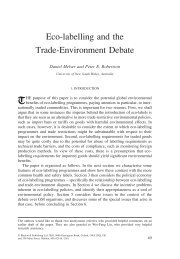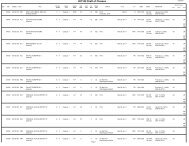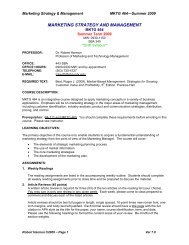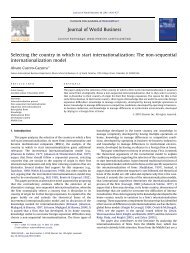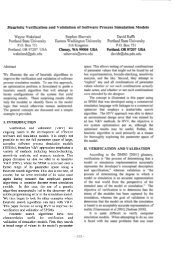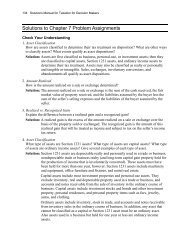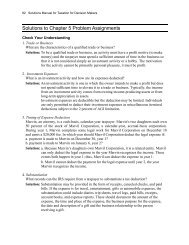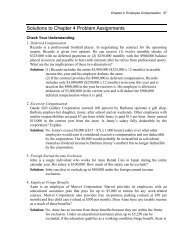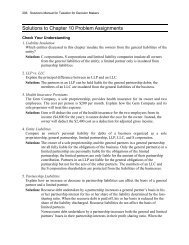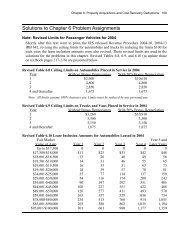Burgerville Supply Chain Case - School of Business Administration ...
Burgerville Supply Chain Case - School of Business Administration ...
Burgerville Supply Chain Case - School of Business Administration ...
Create successful ePaper yourself
Turn your PDF publications into a flip-book with our unique Google optimized e-Paper software.
<strong>Burgerville</strong>:<br />
Sustainability and Sourcing in a QSR <strong>Supply</strong> <strong>Chain</strong><br />
<strong>Case</strong> Study<br />
CGLS-RR-11-01<br />
By<br />
Darrell Brown, PhD.<br />
Phil Berko, MBA<br />
Patrick Dedrick, MIM<br />
Brie Hilliard, MBA<br />
Josh Pfleeger, MIM<br />
Portland State University<br />
CGLS<br />
Center for Global Leadership in Sustainability<br />
<strong>School</strong> <strong>of</strong> <strong>Business</strong> <strong>Administration</strong><br />
Portland State University<br />
P.O. Box 751<br />
Portland, OR 97207-0751<br />
Copyright 2010
<strong>Burgerville</strong>: Sustainability and Sourcing in a QSR <strong>Supply</strong> <strong>Chain</strong><br />
“Doing business locally out <strong>of</strong> the relationships that people had was really important<br />
to this company and the people who were running it. These family kinds <strong>of</strong> values and the<br />
relationships and the way that people interacted with each other was very important and it<br />
was important to keep the money in the communities where we were doing business and the<br />
better job we do <strong>of</strong> doing that the more money people have to spend in your business. So it’s a<br />
circle that works very well. It’s pretty basic economics, actually, and today we call it<br />
sustainability. Years ago they called it ‘that’s the way you do business’.” (Jack Graves, Chief<br />
Cultural Officer, <strong>Burgerville</strong>)<br />
Jack Graves leaned back in his chair and thought about chicken buying chicken; more<br />
precisely, Jack considered where to buy chicken. He needs to make a recommendation to the<br />
purchasing team soon, and the decision is complicated. Jack is a long-time employee <strong>of</strong> the<br />
<strong>Burgerville</strong> restaurant chain, a quick-serve restaurant chain in the Northwest USA. <strong>Burgerville</strong><br />
prides itself in being true to its long-held values while maintaining pr<strong>of</strong>itability and growth.<br />
Graves’ primary job at <strong>Burgerville</strong> is to assure that the company’s values are embedded in all its<br />
actions, including its relationships to its supply chain. His current concern is the dilemma <strong>of</strong> which<br />
values to promote. <strong>Burgerville</strong> sells chicken, lots <strong>of</strong> chicken. So the purchase <strong>of</strong> chicken<br />
significantly influences the social and environmental impacts <strong>of</strong> <strong>Burgerville</strong>’s supply chain. Should<br />
<strong>Burgerville</strong> buy local, with the inherent social and environmental benefits, while paying attention<br />
to concerns about labor issues, animal treatment, and non-organic stewardship? Or should it find a<br />
supplier with some assurance that these potential problems are eliminated regardless <strong>of</strong> location?<br />
Jack knows that <strong>Burgerville</strong> needs to address this issue quickly, as the supply <strong>of</strong> chicken that is<br />
produced to <strong>Burgerville</strong>’s high standards is small and there are sure to be competitors seeking the<br />
same products. He will have to weigh the company’s values and make a recommendation shortly.<br />
As the Chief Cultural Officer <strong>of</strong> The Holland Inc., <strong>Burgerville</strong>’s parent company, Jack Graves<br />
is constantly aware <strong>of</strong> the need to align the <strong>Burgerville</strong> culture and identity throughout all units <strong>of</strong><br />
the business, including vendor partners (APPENDIX 1). The chain’s slogan: “Fresh. Local.<br />
Sustainable.” proclaims its commitment to <strong>of</strong>fering foods differently than other quick serve chains,<br />
with specific attention to where food is being sourced. <strong>Burgerville</strong> aims to deliver on this promise<br />
as consistently as possible, and has had success in the past.<br />
Over the past decade, <strong>Burgerville</strong> has made a concerted effort to ensure that its purchasing<br />
aligns with the company values as consistently as possible. As <strong>of</strong> 2009, over 70% <strong>of</strong> <strong>Burgerville</strong>’s<br />
total spending on food products was from local suppliers, up from less than 60% in 2008<br />
(APPENDIX 2). With chicken, though, Graves was faced with some difficult questions and hard<br />
choices: can <strong>Burgerville</strong> find a local supplier who can provide a sufficient quantity and quality <strong>of</strong><br />
breaded and plain chicken breasts and chicken strips at a cost comparable to the existing national<br />
brand supplier? Is buying local the most important decision to make for <strong>Burgerville</strong> and its<br />
image? Is the issue more than simply reducing the distance the food travels from origin to the<br />
customer? Are <strong>Burgerville</strong> customers willing to pay a premium for locally sourced chicken? It<br />
makes sense to purchase from local farmers who may then become loyal customers, but what if<br />
distant farms operate more sustainably than the local farms? Is there a sustainable chicken farm<br />
that could handle <strong>Burgerville</strong>’s demand? These questions weighed on Graves’s mind as he<br />
struggled to balance the chain’s pr<strong>of</strong>itability with the company’s values.<br />
2
The Company<br />
George Propstra founded <strong>Burgerville</strong> in 1961 when he opened the first restaurant in<br />
Vancouver, WA (APPENDIX 3). Propstra followed in the footsteps <strong>of</strong> his father, Jacob Propstra, a<br />
Dutch immigrant to the area, who founded and owned The Holland Creamery, primarily an ice<br />
cream producer. George ran his restaurant with the same principles that he had learned from his<br />
father – buy local ingredients, treat your employees well, support the local community, and serve<br />
fresh, never frozen products whenever possible. Since 1961, the company, which is still owned by<br />
the family, has maintained these core philosophies.<br />
Now operating 39 restaurants (APPENDIX 4), and a mobile unit known as “The Nomad,” in<br />
Washington and Oregon, <strong>Burgerville</strong> sources local ingredients as <strong>of</strong>ten as possible (APPENDIX 6).<br />
Its seasonal items featured during the peak <strong>of</strong> the harvest emphasize <strong>Burgerville</strong>’s attention to and<br />
creativity around local sourcing (APPENDIX 7). <strong>Burgerville</strong> prides itself on emphasizing products<br />
that are grown or harvested with particular attention to environmental and social impacts.<br />
Specifically, <strong>Burgerville</strong> strives to select ingredients from suppliers that pay particular attention to<br />
the way in which their products are made or grown and to the people that work to produce those<br />
ingredients. Although it is not possible in all cases, they attempted to do so by relying on standards<br />
such as those embodied by the Food Alliance, and carefully selecting farmers, growers, and<br />
products that either already adhere to Food Alliance certification standards or are willing to adapt<br />
their practices to meet those certification standards (APPENDIX 8). Many <strong>of</strong> these ingredients are<br />
sourced from farms in the Pacific Northwest, and the total annual spend on local ingredients for all<br />
<strong>Burgerville</strong> locations represented over $13.2M (APPENDIX 5). As a business that must maintain<br />
pr<strong>of</strong>itability, <strong>of</strong> course, <strong>Burgerville</strong> cannot always meet these stringent standards for every<br />
product it sells. It actively attempts to move closer to these standards in all products and<br />
processes as it continues to grow and evolve. The move to obtain a chicken product closer to the<br />
<strong>Burgerville</strong> core values is what currently concerns Jack.<br />
Overall, <strong>Burgerville</strong> has embraced progressive environmental and social practices for<br />
years. In 2005, the company began purchasing wind energy credits equivalent to 100% <strong>of</strong> its<br />
yearly electrical usage, and recycling as much as it could. In 2007 it instituted a campaign to begin<br />
using compostable products in restaurants. By 2010, the program included all 39 restaurants<br />
with compostable cups, napkins, and food wrappers – 23 restaurants even had on-site access to<br />
composting – and it has diverted enough trash from landfills annually to save approximately<br />
$60,000 per year in hauling costs. This amounts to over 50% <strong>of</strong> <strong>Burgerville</strong>’s divertible trash<br />
being recycled or composted. The percentage was increasing each month.<br />
<strong>Burgerville</strong> prides itself in its attention to its employees as well. In 2010, <strong>Burgerville</strong> had<br />
over 1,300 employees, and provided health insurance coverage for all employees working 20<br />
hours a week or more at a highly subsidized monthly price <strong>of</strong> $20 to the employee and an<br />
additional $20 for the employee’s children. In addition, <strong>Burgerville</strong> actively participates in<br />
employee health and development programs and is known nationally for their ‘best practices’ in<br />
employee treatment.<br />
As broad interest in ‘sustainability’ increased in the United States, attention to and<br />
reporting about corporate social responsibility (CSR) began to rise throughout the business<br />
community. The quick-serve restaurant industry was no exception. At that time many quick-serve<br />
restaurant companies began to publish yearly reports <strong>of</strong> their environmental and social<br />
sustainability efforts, however <strong>Burgerville</strong> chose not to join this trend. Even though <strong>Burgerville</strong><br />
had been conducting business in a way which emphasized its values since day one, it wanted to<br />
avoid being accused <strong>of</strong> “green-washing,” or overemphasizing their CSR and environmental<br />
3
consciousness to generate sales. <strong>Burgerville</strong>, <strong>of</strong> course, wants to be sure to capitalize on the<br />
positive marketing benefits <strong>of</strong> activities inherent to their operations and company culture.<br />
<strong>Burgerville</strong> has received, and highlights, its considerable recognition from local, national, and<br />
industry media for its efforts related to unique, local menu items, employee and social programs,<br />
and environmental practices. This recognition is external validation <strong>of</strong> <strong>Burgerville</strong>’s attempts to<br />
keep its corporate values evident in its actions (APPENDIX 9).<br />
<strong>Burgerville</strong> was started as a small, family run operation, and its growth has not altered the<br />
values on which the company was founded. As the company grows, its commitment to its values<br />
remains central to its identity, meaning that <strong>Burgerville</strong> continues to treat its employees well, and<br />
commits to serving the highest quality product possible that can be procured from local farmers.<br />
This is <strong>Burgerville</strong>’s heritage and it is the culture Jack weighs as he tries to make the right chickensourcing<br />
recommendation.<br />
The Industry<br />
The quick-serve food industry originated as the drive-in restaurant in the 1940s. Offering<br />
food to patrons late into the night, drawing them in with attractive waitresses and bright neon<br />
lights, these drive-ins were the perfect locale for young customers to show <strong>of</strong>f their cars, meet<br />
their friends, and enjoy a burger, shake, and fries. Early drive-in successes included McDonald’s<br />
Famous Hamburgers and Carl’s Drive-In Barbecue, which opened in 1940 and 1945 respectively.<br />
By 1948, the McDonald brothers, founders <strong>of</strong> McDonald’s Famous Hamburgers, re-engineered the<br />
standard diner kitchen and processes to speed up production to meet increasing demand and to<br />
standardize the products <strong>of</strong> their increasing number <strong>of</strong> restaurants. The result is what is now<br />
known as the quick-serve restaurant, in which food is prepared quickly and made available for an<br />
inexpensive price. Included among these early fast food standards were smaller, more limited<br />
menus, and an assembly-line style <strong>of</strong> preparing food. With this new model, one attendant might<br />
grill (or even warm up) meat for a burger, while another added toppings and wrapped it for the<br />
customer, a third might prepare French fries, and yet another prepare milkshakes. Reducing the<br />
number <strong>of</strong> reusable dishes was also critical to this model, and most food was served in disposable<br />
wrappers. This fast, streamlined system was coined as the “Speedee Service System,” and is<br />
considered the original model known as the modern day quick-serve restaurant. Carl's Jr.,<br />
McDonald’s, Taco Bell, Burger King, Wendy's, Kentucky Fried Chicken and countless other<br />
restaurant chains have since based their production model on the Speedee Service System. i<br />
The quick-serve industry is typically known for intense competition, low prices, and<br />
enormous marketing budgets. Industry players compete by differentiating their products from<br />
those <strong>of</strong> their competitors, keeping the menu interesting in order to appeal to constantly changing<br />
consumer preferences, and maintaining low prices. For example, McDonald’s innovated on the<br />
burger package in the 1990’s by creating a box with a “hot” side and a “cold” side for the now<br />
discontinued McDLT. In 1997, Burger King spent $70m advertising their newly developed fries in<br />
order to attract consumers to the “best” fries in the market, and steer them away from competitor<br />
McDonald’s. ii Taco Bell maintains differentiation by <strong>of</strong>fering Mexican-style food which appeals to<br />
mainstream tastes. In 2009, the chain launched a menu item that included bacon to diversify its<br />
<strong>of</strong>ferings and capitalize on parallel trends found in burger and fry quick-serve restaurants. Most <strong>of</strong><br />
the national chains advertise ‘Dollar menus’ or ‘Value meals’ emphasizing the low cost <strong>of</strong> their<br />
<strong>of</strong>ferings. Recent interest in issues concerning the social costs <strong>of</strong> poor nutrition and obesity add<br />
another dimension to which the industry players can differentiate their products, resulting in<br />
quick-serve companies competing on their ability to serve customers ‘healthy’ foods’. Currently,<br />
4
in addition to traditional fare, most national quick-serve chains advertise a limited selection <strong>of</strong><br />
low-carb menus, ‘real’ fruit smoothies, salads, and ‘kid-friendly’ snacks such as apple slices.<br />
Typical Quick-Serve Industry Sourcing<br />
The quick-serve industry typically divides its food purchases into two categories –<br />
proprietary and conventional. Proprietary items are processed items that have been custom<br />
formulated for the equipment, packaging, standards and menu items <strong>of</strong> a specific restaurant chain.<br />
The restaurant chains purchase these at a contract price, and they may include French fries,<br />
milkshakes, ice cream, meats, and toppings—any food items that are unique to a particular chain.<br />
Conventional items are more commoditized and are generally used by a variety <strong>of</strong> different<br />
chains and generally include condiments, produce, and s<strong>of</strong>t drinks. Prices for conventional items<br />
tend to be market based and negotiated through corporate <strong>of</strong>fices. Many restaurant chains enter<br />
into long-term agreements with suppliers to ensure a steady supply <strong>of</strong> the quantities needed at a<br />
predictable price. These agreements <strong>of</strong>ten put downward pressure on prices, reducing total costs<br />
to purchasing chains, either increasing the pr<strong>of</strong>it margins <strong>of</strong> the final products to the restaurants<br />
or reducing the costs to the ultimate restaurant consumer, or both.<br />
In recent years, the practices <strong>of</strong> national and global quick-serve companies have come<br />
under considerable criticism. A number <strong>of</strong> chains have been criticized for forcing supplier prices<br />
down so far that wages paid to farm laborers are below subsistence levels. iii In response to the<br />
reputational damage that a supplier’s business practices can do to the chains, McDonald’s<br />
circulated a “Code <strong>of</strong> Conduct for Suppliers” in 2000. iv This document aims to address the social<br />
issues that surround the relationship restaurant chains have with their suppliers, and includes<br />
standards for:<br />
Compliance with local laws<br />
Prohibition <strong>of</strong> prison, forced, and child labor<br />
Compensation<br />
Work schedule<br />
Discrimination<br />
Working conditions<br />
<br />
<br />
Inspections by supplier personnel<br />
Inspections by restaurant personnel<br />
Similar concerns about the treatment <strong>of</strong> animals throughout the supply chain <strong>of</strong> quickserve<br />
restaurants resulted in public responses to mitigate potential damage to corporate and<br />
industry reputations. For example, Burger King responded in 2007 with guidelines for their<br />
suppliers regarding care, housing, transport, and slaughter <strong>of</strong> animals. v<br />
Sourcing issues also are an area <strong>of</strong> concern for the quick-serve industry. In India, where<br />
McDonald’s demand for lettuce encouraged farmers to adjust their agricultural practices to grow<br />
lettuce year-round rather than only during the winter months to provide for McDonald’s needs.<br />
While this allowed for McDonald’s locations in India to source local produce, this decision also<br />
affected the overall agricultural industry within the affected areas <strong>of</strong> India, as it changed the<br />
production <strong>of</strong> formerly grown produce vi .<br />
5
Local Sourcing<br />
The concept <strong>of</strong> promoting local food systems has recently gained popularity, partially as a<br />
counter to consolidation and practices <strong>of</strong> industrial agriculture. The goal <strong>of</strong> the ‘local food<br />
movement’ is to shift away from globalized networks <strong>of</strong> distribution and revert to local<br />
communities supported by, and supportive <strong>of</strong> local production. Local food systems provide<br />
primarily what is readily accessible in the local geographies. This movement hopes to contribute<br />
to economically sustainable, environmentally beneficial, and socially supportive communities.<br />
Local food systems generally minimize ‘food miles,’ support farms able to patronize the businesses<br />
to which they supply product, and rely on, and pay, local labor. Beyond the potential advantages <strong>of</strong><br />
local food quality, the local food movement tends to encourage more socially and environmentally<br />
sustainable food production and sourcing through intentional spending.<br />
Changes in food system preferences are characterized by consumer interest in many forms,<br />
ranging from a wide variety <strong>of</strong> third party certifications for ‘organic’ or ‘sustainable’ products to a<br />
dramatic increase in the number <strong>of</strong> local farmers’ markets, springing up all around the United<br />
States. The total number <strong>of</strong> farmers’ markets in the United States and Canada has grown by over<br />
20% from 2006 to 2009, to nearly 6,000 total markets. vii Beyond the level <strong>of</strong> individual<br />
households, the local food movement has reached a point at which it calls for participation from<br />
larger entities to source their food products with particular attention paid to the “locality” <strong>of</strong> those<br />
products, striving to maximize the foods that are grown locally.<br />
One metric commonly used to evaluate local food is the “food mile.” In essence, food miles<br />
are an expression <strong>of</strong> the distance that a food product travels geographically from the point <strong>of</strong> its<br />
origin to its final destination. viii Food miles may use actual miles traveled, or may calculate a<br />
carbon value for a product in the form <strong>of</strong> the emissions generated during the transport <strong>of</strong> a<br />
product along each step in its supply chain. This metric, if known, allows consumers to become<br />
aware the impact their food choices may have on the environment and allows them to alter their<br />
personal environmental impact by choosing products that have as many or few food miles as<br />
desired. ix For example, a consumer in Denver, Colorado wishing to reduce her personal carbon<br />
footprint might choose to eliminate bananas from her diet, since they cannot be grown in the<br />
Intermountain West, and must come from a farm in the Caribbean or Central America. Ideally,<br />
individuals will consume only foods that they get from retailers who make concerted efforts to<br />
stock local foods or at smaller farmers’ markets or community supported agriculture services,<br />
where consumers buy directly from farmers and artisans.<br />
Bringing Food to <strong>Burgerville</strong><br />
<strong>Burgerville</strong> locations are typically run by a manager and two assistant managers. This<br />
management team is responsible for placing orders for their own restaurants from <strong>Burgerville</strong><br />
authorized distributors, who make deliveries directly to the stores three times per week. The<br />
accompanying invoices are sent to the corporate <strong>of</strong>fice, where they get paid. This direct delivery is<br />
an alternative to using a commissary which would distribute foodstuffs internally among<br />
<strong>Burgerville</strong> locations.<br />
<strong>Burgerville</strong>, like other quick serve restaurants, constantly refines its menu items. Unlike<br />
many <strong>of</strong> its competitors, however, for <strong>Burgerville</strong> this refinement includes adding vegan and<br />
vegetarian options, fish, and limited time <strong>of</strong>fer seasonal items. The company began <strong>of</strong>fering these<br />
rotating menu items based around seasonal foods in 2008 and have begun asking local “foodies,”<br />
and celebrity chefs to create new <strong>of</strong>ferings. Typical items include entrée sandwiches or side order<br />
items such as “The Roasted Turkey & Cherry Chutney Wrap” (APPENDIX 10), developed by Allison<br />
6
Hensey, director <strong>of</strong> The Oregon Environmental Council. A percentage <strong>of</strong> the proceeds for this<br />
particular item benefit the Council, supporting the ‘healthy foods and farms’ program and<br />
promoting the environmental stewardship and economic vitality <strong>of</strong> Oregon's farmers and<br />
ranchers. Additional seasonally rotated items include fresh, local berry milkshakes, Fried<br />
Portobello Mushroom Wedges, Fried Asparagus Spears, and Walla Walla Sweet Onion Rings, and<br />
are eagerly anticipated by patrons each year. Ingredients for most <strong>of</strong> these items are not part <strong>of</strong><br />
<strong>Burgerville</strong>'s normal food inventory, nor <strong>of</strong> its distributors’ product lines. As such, seasonal<br />
ingredients must be sourced and incorporated into the <strong>Burgerville</strong> supply chain as new menu<br />
items.<br />
<strong>Burgerville</strong>’s mission to support local farms and local businesses has extended to the<br />
current day, where local ingredients are needed to supply 39 different locations with standard<br />
menu items in addition to these specialty and seasonal items. <strong>Burgerville</strong> pioneered a unique<br />
farmer-distributor system that allows them to maintain relationships with local farmers, as well as<br />
introduce those farmers to other potential customers and distribution channels. In this system,<br />
<strong>Burgerville</strong> will find a local farm that produces a specific product that they need for a menu item.<br />
Then they will go to one <strong>of</strong> their two main distributors, Sysco Corporation and their subsidiary<br />
Fulton Provisions and arrange for the farmer to supply products to the distributor (APPENDIX<br />
11). From this point, <strong>Burgerville</strong> can simply add the product to the regular orders they receive<br />
from that distributor, as well as give other firms that use that distributor access to the products.<br />
Sourcing the product through a distributor means that the farmers can focus on agriculture<br />
instead <strong>of</strong> distribution. Troy Thomas, head <strong>of</strong> produce procurement for Sysco Corporation, one <strong>of</strong><br />
<strong>Burgerville</strong>’s main distributors, says: “This allows us to do what we do best – transport food, while<br />
allowing the farmers to do what they do best – grow good food.” <strong>Burgerville</strong> sees the inherent<br />
value in this consumer-producer relationship that varies from the more common, consumerdistributor<br />
relationship seen in supermarkets around America. The farmer benefits through<br />
access to a market that is larger than <strong>Burgerville</strong> alone, while other customers seeking local<br />
products benefit by having access to new products through their normal distribution methods.<br />
This farmer-distributor system serves to benefit <strong>Burgerville</strong>, local farmers, associated distributors,<br />
and consumers, all by making local food more widely available (APPENDIX 12).<br />
Past Sourcing Issues<br />
Jack Graves, as a long time <strong>Burgerville</strong> employee, is well aware <strong>of</strong> the past supply chain<br />
decisions. In various ways, these decisions have built an expectation that, through creative work<br />
with suppliers and a willingness to deviate from standard industry practices, <strong>Burgerville</strong> can<br />
indeed maintain its economic vitality while adhering to and promoting its core values (APPENDIX<br />
13). These, and other initiatives <strong>Burgerville</strong> implemented, have made <strong>Burgerville</strong> a leader and<br />
innovator in sustainability in the quick-serve restaurant industry. Jack is proud <strong>of</strong> that leadership<br />
role.<br />
Country Natural Beef<br />
Fresh, never frozen, beef has been a vital part <strong>of</strong> <strong>Burgerville</strong>’s identity since George<br />
Propstra grilled the first <strong>Burgerville</strong> hamburger. In order to meet this requirement, <strong>Burgerville</strong><br />
must source its beef locally. However, the concerns <strong>of</strong> procuring beef for <strong>Burgerville</strong> go beyond<br />
7
geography. While purchasing beef locally met the goal <strong>of</strong> never serving previously frozen beef, a<br />
wide variety <strong>of</strong> environmental and social issues, including concerns about the health and<br />
treatment <strong>of</strong> the livestock remained important to <strong>Burgerville</strong> as well. The traditional factory<br />
farming system, <strong>of</strong> beef production, is laden with environmental and social concerns; the task <strong>of</strong><br />
producing the quantities <strong>of</strong> beef needed to supply an enterprise <strong>of</strong> <strong>Burgerville</strong>’s size generally<br />
leads to farming conglomerates, <strong>of</strong>ten contributing to the decline in family farming, farm<br />
communities, and the rancher lifestyle. <strong>Burgerville</strong> was also concerned about the treatment <strong>of</strong> the<br />
animals that would eventually be sold as hamburgers to final customers.<br />
In the United States, most conventional cattle are raised on pasture and moved to feed lots<br />
for several months and feed a diet <strong>of</strong> grains and corn. The feed lot is a fast and efficient fattening<br />
process and a quick turnaround to slaughter. As this lifestyle is not conducive to forming the<br />
muscle mass naturally developed in cattle, it is common for industrial beef producers to treat<br />
cattle heavily with hormones. This, combined with the tightly packed and unnaturally sedentary<br />
lifestyle that this production method encourages, has led to increased social awareness and outcry<br />
over treatment <strong>of</strong> the cattle. Moreover, slaughterhouses have been known for poor sanitation,<br />
excessive line speeds, animal cruelty, and poorly enforced regulations, all <strong>of</strong> which contribute to<br />
oppressive working conditions, high rates <strong>of</strong> workplace injuries, and a history <strong>of</strong> food borne<br />
pathogens.<br />
Country Natural Beef uses a business model that provides a large quantity <strong>of</strong> dependable<br />
production with a stark contrast to conventional factory-farming. Due to this more sustainable<br />
ranching model they have enjoyed a mutually beneficial relationship with <strong>Burgerville</strong>. x The<br />
Country Natural Beef Cooperative (CNB) consists <strong>of</strong> nearly 120 family ranches, primarily in the<br />
Northwest, all <strong>of</strong> which come together for the common goal <strong>of</strong> providing customers with locally<br />
raised, humanely-treated, and chemical-free natural beef. To ensure that CNB produces<br />
consistent, high quality products the ranchers maintain ownership <strong>of</strong> the cattle throughout the<br />
value chain. The only exception is while the cattle are at CNB’s partner feedlot, Beef Northwest.<br />
At Beef Northwest, the CNB cattle are fed a diet comprised <strong>of</strong> cooked potato products, sunflowers<br />
and dry distillers’ grain, in contrast to the factory-farming standard diet <strong>of</strong> corn.<br />
Once the cattle have reached the appropriate weight, Beef Northwest trucks the cattle to a<br />
slaughterhouse owned by AB Foods. AB Foods is a relatively progressive company for the<br />
industry with ranching roots that focus on high quality products, animal well being, and humane<br />
slaughter. The cattle are slaughtered two days per week on the first shift <strong>of</strong> the day to minimize<br />
the risk <strong>of</strong> microbial contamination. AB Foods boxes the beef and sends it to Fulton Provisions, a<br />
secondary processor and distributor. In addition to cutting steaks, grinding burger and<br />
distributing these products from boxed beef, Fulton grinds, forms patties, and packages burgers<br />
for <strong>Burgerville</strong> restaurants. Each <strong>of</strong> these intermediaries abides by Food Alliance certification<br />
standards and CNB's additional specifications in regard to treatment <strong>of</strong> animals, processes for<br />
treating sick animals, record keeping, and sanitation. xi Importantly, all <strong>of</strong> these intermediaries are<br />
local, which allows ranchers a great deal <strong>of</strong> control throughout all stages <strong>of</strong> production (APPENDIX<br />
14).<br />
Prior to their relationship with Country Natural Beef, in order to meet the volume<br />
requirements <strong>of</strong> the entire chain <strong>of</strong> restaurants, <strong>Burgerville</strong> purchased their beef from<br />
conventional sources. Jack Graves saw that, considering <strong>Burgerville</strong>’s values around sourcing, the<br />
fit with Country Natural Beef is clear – CNB provides fresh beef, from a local and community<br />
oriented source. It has an unwavering focus on sustainability and through a co-op model, has<br />
attained the production capacity to meet <strong>Burgerville</strong>’s year round demand.<br />
8
Liepold Farm Berries<br />
As Jack considered the decision for sourcing chickens, he also recalled a decision five years<br />
ago, one he was proud <strong>of</strong> for its social impacts. In that decision he felt that <strong>Burgerville</strong> had really<br />
made a difference that mattered to the local community. He wondered whether this decision could<br />
have a similar outcome. He hoped so.<br />
When it comes to sourcing produce for <strong>Burgerville</strong>, local farmers have always come first,<br />
but strawberry farming in the Pacific Northwest is somewhat problematic. Oregon strawberries<br />
ripen on the vine more slowly than in other commercial areas such as California and Florida,<br />
where the climate is much warmer and drier in the spring months. Because <strong>of</strong> this slow ripening<br />
process during the cooler Pacific Northwest springs, Oregon berries have been shown to be<br />
sweeter than others. When the taste and nutritional integrity <strong>of</strong> six varieties <strong>of</strong> Oregon<br />
strawberries and five varieties <strong>of</strong> California strawberries were analyzed, five out <strong>of</strong> the six Oregon<br />
varieties were sweeter than all <strong>of</strong> the California berries tested. xii This sweetness makes them<br />
perfect for <strong>Burgerville</strong>’s spring milkshakes.<br />
Unfortunately for Oregon berry producers, however, Oregon-grown strawberries are much<br />
more fragile than California strawberries, which can better withstand machine picking as whole<br />
berries. When whole berries are desired, Oregon berries must be picked by hand in order to<br />
prevent bruising, making it very labor intensive work. Berry farmers are faced with the task <strong>of</strong><br />
finding workers willing to do difficult work for low wages for only two months a year. xiii Under<br />
normal conditions, if wages were to increase in an effort to attract more workers, small Oregon<br />
farmers would likely be put out <strong>of</strong> business. Large-scale corporate farms produce hardy berries<br />
from California at a lower price than Oregon farmers can meet. As a result, wages stay low and<br />
willing workers stay scarce. In recent years, berries have been rotting on the vine and farmers<br />
have lost their crops, not because <strong>of</strong> a lack <strong>of</strong> demand, but because the limited number <strong>of</strong> willing<br />
workers cannot pick berries fast enough. Many berry producers have turned to mechanical<br />
picking and producing frozen, rather than whole, berries.<br />
<strong>Burgerville</strong> differentiates itself on its values, and as such tries to live by their values with<br />
each purchase they make. When considering the fit between their values and relationships with<br />
their berry suppliers they found an opportunity for improvement. Historically, <strong>Burgerville</strong><br />
purchased the first berries on the market. They were not purchasing consistently and had no<br />
embedded relationship with any single berry producer. In 2005, however, they partnered with<br />
Liepold Farms, a family farm near a small town not far from Portland, for the majority <strong>of</strong> their<br />
berry needs. In this partnership, <strong>Burgerville</strong> saw a chance to both obtain local foods and also<br />
reinforce its social values. Liepold produced high quality berries, <strong>of</strong> course, but in addition they<br />
also treated their farm workers with uncommon care. Liepold Farms special attention to their<br />
workers added costs most farms avoided, meaning that while the farm was socially responsible it<br />
was also financially fragile. Graves saw congruence to <strong>Burgerville</strong>’s values with those <strong>of</strong> Liepold<br />
Farms, specifically as they related to the treatment <strong>of</strong> workers employed on the farm.<br />
Farm workers’ rights, always an interest <strong>of</strong> <strong>Burgerville</strong>, has also become an important food<br />
system issue for consumers. xiv <strong>Burgerville</strong> saw, with Liepold, an opportunity to address the issue<br />
<strong>of</strong> farmer workers’ rights, and to support a local family farm. Liepold Farms set themselves apart<br />
from many <strong>of</strong> the other local berry farmers by providing good housing for their employees on the<br />
farm-site – they house up to 70 employees on their farm during peak season. As an indicator <strong>of</strong> the<br />
worker satisfaction with Liepold, for example, for the past 20 years the same families have<br />
returned to work on the farm. Liepold Farms developed relationships with their workers by<br />
9
paying them a fair wage, providing housing, and taking care <strong>of</strong> additional medical expenses. This is<br />
exactly the type <strong>of</strong> employee treatment that <strong>Burgerville</strong> looks for when selecting a supplier,<br />
reflecting the way that <strong>Burgerville</strong> treats its own employees. Liepold Farms’ values represent the<br />
values that embody the <strong>Burgerville</strong> brand.<br />
Once <strong>Burgerville</strong> made the decision to partner with Liepold Farms, they helped the farm to<br />
become completely integrated in a system <strong>of</strong> distribution through Sysco Corporation. By bringing<br />
Liepold Farms into a larger supply chain, <strong>Burgerville</strong> now gets regular deliveries <strong>of</strong> fresh Liepold<br />
strawberries and raspberries, making a significant financial difference for the farm. Fresh berries<br />
sell at a 100% premium over frozen berries, which is the way most Oregon strawberries must be<br />
sold. By having a partnership with <strong>Burgerville</strong>, Liepold can be confident that they can keep taking<br />
care <strong>of</strong> their workers while still making a pr<strong>of</strong>it on the farm. Their products are also now available<br />
to all <strong>of</strong> Sysco’s clients, giving Liepold an enormous opportunity for future sales growth. Mr.<br />
Liepold says “if it wasn’t for <strong>Burgerville</strong> and the fresh market, [we] probably wouldn’t be doing<br />
what [we] are doing now.” If their customers were only buying less expensive frozen berries,<br />
Liepold Farms would not exist as it does, and <strong>Burgerville</strong> would likely not have this kind <strong>of</strong> partner<br />
vendor to provide fresh, local berries.<br />
Portland Roasting C<strong>of</strong>fee<br />
In recognizing that they might, in order to meet some <strong>of</strong> the <strong>Burgerville</strong> values, need to<br />
source the chickens from outside the local area, Jack thought about other times <strong>Burgerville</strong> made<br />
intentional, non-local purchases. The most recent example, which Jack thought was well<br />
conceived, was sourcing c<strong>of</strong>fee from Portland Roasting Company (PRC).<br />
C<strong>of</strong>fee presents a special sourcing issue for <strong>Burgerville</strong>, as there are no local farms in the<br />
Pacific Northwest that grow c<strong>of</strong>fee. C<strong>of</strong>fee can only be grown in tropical and subtropical<br />
environments. C<strong>of</strong>fee is one <strong>of</strong> the worlds’ the most heavily traded agricultural commodities and<br />
has considerable social and environmental impact. Throughout c<strong>of</strong>fee’s long history, it has<br />
traditionally been shade-grown in forested plantations. However, in the last thirty years, c<strong>of</strong>fee<br />
plants that are more tolerant to the sun have been developed. C<strong>of</strong>fee growers have been able to<br />
employ growing methods that expose c<strong>of</strong>fee plants to direct sunlight, meaning a potential crop<br />
yields up to two or three times that <strong>of</strong> shade-grown methods. This shift in growing methods led to<br />
massive deforestation <strong>of</strong> former c<strong>of</strong>fee growing regions and a dramatic shift from small farms<br />
supporting one or two families to large corporate farms, with a concurrent dramatic reduction in<br />
the number <strong>of</strong> people supported by the farms.<br />
The massive environmental and social disruptions caused by c<strong>of</strong>fee, and the importance <strong>of</strong><br />
c<strong>of</strong>fee to the developed world, have resulted in the industry becoming a major focus <strong>of</strong> both the<br />
social and environmental sustainability movements. <strong>Burgerville</strong>, when considering how to create<br />
fit between its values and the need to provide c<strong>of</strong>fee to its customers, identified a set <strong>of</strong> options for<br />
choosing its supplier. Typically these options include Fair Trade certification, Rain Forest Alliance<br />
certification, or no certification and a choice based solely on cost. Fair Trade certification is<br />
socially based, with customers such as <strong>Burgerville</strong> paying more than the base market price to<br />
producers in order to help them develop and improve their ability to continue to farm as family<br />
farms. The Rainforest Alliance, by contrast, looks at the environmental impact <strong>of</strong> farming<br />
methods, and aims to certify c<strong>of</strong>fee that is grown with techniques that do not diminish or harm the<br />
biodiversity <strong>of</strong> sensitive c<strong>of</strong>fee growing areas.<br />
In the process <strong>of</strong> looking for a local c<strong>of</strong>fee vendor for their restaurants, however,<br />
<strong>Burgerville</strong> looked beyond standard third-party certified c<strong>of</strong>fee roasters. The company elected to<br />
10
source their c<strong>of</strong>fee from Portland Roasting C<strong>of</strong>fee (PRC), due to their “Farm Friendly Direct”<br />
program. Farm Friendly Direct is a c<strong>of</strong>fee sourcing program which aims to support sustainable<br />
growth and lifestyle improvement for PRC’s c<strong>of</strong>fee growers by paying above-market prices for the<br />
c<strong>of</strong>fee, with the stipulation that this premium finances farm and community assistance projects.<br />
To date, these projects have included: reforestation initiatives, construction <strong>of</strong> water treatment<br />
facilities and water pumps, community centers, and schools.<br />
Portland Roasting was founded in 1996 with the mission <strong>of</strong> supporting farmers who had a<br />
dedication to stewardship <strong>of</strong> the land that provided for them. From the outset, Portland Roasting<br />
focused on sustainable methods, but struggled to find third-party certifications that aligned with<br />
their goals. This eventually led PRC to create a proprietary, first party certification program –<br />
Farm Friendly Direct. By focusing on direct and tangible community improvements, as opposed to<br />
merely paying an above-market premium, Portland Roasting is able to ensure that their sourcing<br />
strategy contributes directly to the betterment <strong>of</strong> the community <strong>of</strong> their c<strong>of</strong>fee growers. The fit<br />
was clear; while there were no local c<strong>of</strong>fee farmers for <strong>Burgerville</strong> to support, it could support<br />
Portland Roasting, a local roasting company. Further, through this relationship, <strong>Burgerville</strong>’s<br />
c<strong>of</strong>fee purchases support direct tangible benefits to farmers and farming communities throughout<br />
the developing world, while providing their customers with an award winning, premium product.<br />
Jack wondered whether he could learn from the PRC experience to inform his decision about<br />
chickens.<br />
Current Sourcing Issue<br />
American chicken farmers annually raise roughly 35 billion pounds <strong>of</strong> chicken. xv To<br />
generate this level <strong>of</strong> productivity, farmers have a number <strong>of</strong> options for raising their animals<br />
including conventional methods, pasture raised methods, and organic methods. By far, the most<br />
widespread method <strong>of</strong> raising chickens for meat is the conventional method. This production<br />
method holds the birds in large climate-controlled production houses where they are fed, watered<br />
and regularly given antibiotics. These chickens are generally alive for six weeks before slaughter.<br />
This method produces the most meat at the cheapest price.<br />
But, the real cost <strong>of</strong> this method <strong>of</strong> chicken production includes social and environmental<br />
costs, however. The crowded production houses create conditions highly conducive to disease. To<br />
combat this, antibiotics are systematically administered to chickens in their feed, injected into<br />
young chicks, and into eggs prior to hatching. While antibiotics help to alleviate the problem <strong>of</strong><br />
disease, they result in additional problems. In 1995, the US Food and Drug <strong>Administration</strong> (FDA)<br />
approved a class <strong>of</strong> antibiotics, called fluoroquinolones, for use in poultry. Five years later,<br />
fluoroquinolones were banned in agriculture, citing evidence that human resistance to the drug<br />
had risen since their FDA approval, which has lead to further health problems in humans. xvi The<br />
use <strong>of</strong> antibiotics also creates problems downstream <strong>of</strong> the farm as up to 75% <strong>of</strong> antibiotics can<br />
pass through an animal un-digested, enter water reservoirs, and potentially impact humans or<br />
other animals. xvii The perennial use <strong>of</strong> antibiotics in commercial production houses develops an<br />
environment where resistant bacteria evolve. Over time, chickens come in contact with the more<br />
resilient bacteria, which then pass through as processed poultry, and are consumed by humans. If<br />
antibiotic resistant bacteria later infect humans or livestock, the primary courses <strong>of</strong> treatment are<br />
unlikely to be effective and potentially lead to health complications.<br />
The most prevalent alternative to production houses is pasture-raised chicken farming, a<br />
special case <strong>of</strong> free-range chicken production. Jack knows that the free-range designation is<br />
11
difficult to interpret as access to the outside is all that is needed to qualify a chicken as free-range.<br />
In many cases, the difference between conventional and free-range production is that a densely<br />
packed production house has an open door at one end. One reason that <strong>Burgerville</strong> supports<br />
certifications such as Food Alliance is that the certification provides more information about the<br />
conditions <strong>of</strong> the animals as they are raised.<br />
Pasture-raised chickens are permitted to roam freely outside, similar to the way cattle are<br />
allowed to graze at pasture. This requires a lower animal density and reduces the need for<br />
antibiotics. Animals that do get sick while being pasture-raised can be treated with medications,<br />
but rarely undergo prophylactic drug therapies to ensure growth. Pasture-raised chickens need<br />
more time to grow and gain weight and normally live for 8 weeks before slaughter. Since chickens<br />
are allowed to roam outside, they are, however, more vulnerable than conventionally raised hens.<br />
Production houses are protected from birds <strong>of</strong> prey, foxes, raccoons, and other predators but<br />
chickens venturing out <strong>of</strong> coops may be susceptible to predators. While farmers keep birds inside<br />
during periods <strong>of</strong> inclement weather, sudden weather changes may catch the birds outside and<br />
leave them vulnerable to drowning. Parasitic worms that live in the soil can also infect the birds,<br />
another condition uncommon in production houses.<br />
Certified Organic farming further restricts the farm’s operations by mandating that all food<br />
given to the birds be free <strong>of</strong> genetically modified feed and organically farmed. Restrictions are<br />
also placed on beak-trimming and claw modifications, which are procedures done to prevent hens<br />
from eating their own eggs and hurting other chickens. In order to sell poultry as USDA Organic, it<br />
must be certified by a USDA approved, third-party certifier.<br />
<strong>Burgerville</strong> and Chicken<br />
<strong>Burgerville</strong> <strong>of</strong>fers 6 menu items with fried or grilled chicken and spent over a million<br />
dollars on chicken in 2009. Jack Graves wondered if <strong>Burgerville</strong> should consider changing the<br />
source <strong>of</strong> its chicken to increase its local purchasing quotient. A large regional supplier would be<br />
able to supply <strong>Burgerville</strong> with the quantity <strong>of</strong> chicken it needs from its processing plants in<br />
Washington and Oregon, but these were conventional producers with the social, environmental,<br />
and animal treatment problems. Purchasing locally could support smaller local farmers, keeping<br />
more <strong>of</strong> the money within the local communities. The economic impact <strong>of</strong> this quantity <strong>of</strong><br />
purchases could have a significant impact on the farms and communities where the purchases are<br />
made. An economic impact study <strong>of</strong> poultry production indicates that every $1 million <strong>of</strong> sales by a<br />
poultry or egg producer generates 20.1 FTE jobs (APPENDIX 15). A problem with many <strong>of</strong> the<br />
smaller farms, however, is they lack the ability to supply sufficient numbers <strong>of</strong> consistently sized<br />
portions. Jack recalled an attempt a few years ago to source chicken locally, and the variation in<br />
portion sizes caused considerable consumer backlash and excess waste. At this time there is no<br />
local farm using non-conventional production processes that can dependably provide the quantity<br />
<strong>of</strong> high-quality chicken that <strong>Burgerville</strong> needs.<br />
Coleman Natural, a chicken supplier from Colorado was under consideration by Jack and<br />
his supply chain team. <strong>Burgerville</strong> had been testing Coleman’s product with good results in a few<br />
restaurants. Coleman Natural supplies some organic and antibiotic-free chicken and may choose<br />
to earn the first Food Alliance certification for at least some <strong>of</strong> its poultry meat. The chickens<br />
themselves would be sourced from the Southern United States, however, as Coleman’s processor<br />
capable <strong>of</strong> providing a dependable supply <strong>of</strong> consistently sized portions is based in Georgia. While<br />
this supplier <strong>of</strong>fers some sustainably raised chickens, there is an additional environmental impact<br />
that <strong>Burgerville</strong> would incur for their products, in the form <strong>of</strong> emissions related to the<br />
12
transportation and storage <strong>of</strong> chickens to restaurant locations. And <strong>of</strong> course, purchasing from the<br />
southern US is not really very local. Since Coleman could choose to obtain Food Alliance<br />
certification, Jack could see that partnering with <strong>Burgerville</strong> might provide the impetus to actually<br />
make the move to certification. It would be good to see Food Alliance expand its reach into the<br />
South, where its impact could be significant.<br />
Jack Graves could see that, regardless <strong>of</strong> his decision, some <strong>of</strong> <strong>Burgerville</strong>’s values would be<br />
served better than others, and he has a number <strong>of</strong> alternatives to choose from. He can continue<br />
buying conventionally produced chicken or try a new source (develop relationships with<br />
individual local farmers or buy Coleman's chicken from the southern US). Each <strong>of</strong> these choices<br />
has different pros and cons. The task at hand for Jack Graves is to put together a recommendation<br />
that best fits as many <strong>of</strong> <strong>Burgerville</strong>’s core values as possible. In a few days, the supply chain team<br />
will meet to make the chicken sourcing decision, and Jack wants to have thought these issues<br />
through before the meeting.<br />
13
Appendices<br />
Appendix 1 – <strong>Burgerville</strong> Organization<br />
Chart<br />
14
Appendix 2 – Food Spend<br />
15
Appendix 3 – <strong>Burgerville</strong> Timeline<br />
Appendix 4 – Map <strong>of</strong> <strong>Burgerville</strong> Locations<br />
16
Appendix 5 – Local Farmer Map<br />
Farm/Supplier Ingredients Sourced Location<br />
Country Natural Beef Meat Vale, OR<br />
Odyssey Seafood Seafood Seattle, WA<br />
Diestel Farms Poultry & Eggs Sonora, CA<br />
Steibrs Farm Eggs Yeim, WA<br />
Liepold Farms Berries Boring, OR<br />
Lamb Weston Produce Quincy, WA<br />
Sunshine Dairy Dairy Portland, OR<br />
Tillamook Creamery Cheese & Dairy Tillamook, OR<br />
LiteHouse Foods Condiments Sandpoint, ID<br />
Portland Roasting C<strong>of</strong>fee Portland, OR<br />
18
Appendix 6 –<strong>Burgerville</strong> Nomad<br />
19
Appendix 7 –Regular Menu and Seasonal Items<br />
20
Seasonal Items<br />
Appendix 8 – Food Alliance Certification<br />
Food Alliance (FA) is a third party nonpr<strong>of</strong>it that certifies farms, ranches and food handlers<br />
according to a holistic standard that takes into considerations working conditions, treatment <strong>of</strong><br />
animals, environmental stewardship, and social practices (see Food Alliance Standards <strong>of</strong><br />
Excellence, below). FA also provides independent verification <strong>of</strong> marketing claims for social and<br />
environmental responsibility. By looking at the whole operations <strong>of</strong> a company, FA reassures food<br />
buyers that they are supporting fair working environments, humane animal treatment, and<br />
environmental stewardship by their food providers and that supporting their food providers’<br />
social initiatives makes a difference.<br />
22
FA got its start in 1998 with a single apple orchard and has grown to certify over 320 farms<br />
and ranches in Canada, Mexico, and in 23 US states. In all, over 5.6 million acres <strong>of</strong> farmland and<br />
ranchland are certified. In addition, FA has certified 6 distribution centers and 18 food-processing<br />
facilities. While the certification is voluntary and requires the payment <strong>of</strong> a nominal fee,<br />
businesses that earn the certification see sales increases resulting from positive customer<br />
feedback, increased customer loyalty, access to new markets, access to contracts, and price<br />
premiums. This is similar to purveyors who opt for organic certifications and otherwise act to<br />
differentiate foods that are otherwise viewed as commodities by consumers' eyes.<br />
Nonmonetary benefits are clear as well. According to their website, “Food Alliance has also<br />
documented improved practices on participating farms and ranches leading to better conditions<br />
for thousands <strong>of</strong> workers, more humane treatment <strong>of</strong> hundreds <strong>of</strong> thousands <strong>of</strong> animals, and<br />
reduced pesticide use, healthier soils, cleaner water, and enhanced wildlife habitat on millions <strong>of</strong><br />
acres <strong>of</strong> range and farmland.”<br />
While other certifications focus on the farming process as organic certifications do, or<br />
processes, as in ISO certifications, FA aims to certify the sustainable farming <strong>of</strong> individual crops.<br />
While other certifications focus on the farming (i.e. organic) or processes (i.e. ISO 14000), FA aims<br />
to write unique standards for many crops and animals including Beef Cattle, Bison, Dairy, Pigs,<br />
Poultry and Eggs, Apples, Barley, Beans, Citrus, Mushrooms, Peaches, Rhubarb, Spinach, and, both,<br />
Field and Sweet Corn.<br />
Food Alliance Standards <strong>of</strong> Excellence<br />
Conserve energy, reduce and recycle waste<br />
Waste streams from food production are minimized while reuse, recycling, and composting <strong>of</strong> resources<br />
is maximized. <strong>Business</strong>es invest in innovation and improvement to ensure efficient use and management<br />
<strong>of</strong> natural resources for energy and packaging, transport, and daily operations.<br />
Reduce use <strong>of</strong> pesticides, and other toxic and hazardous materials<br />
Food businesses avoid use <strong>of</strong> chemicals that have adverse impacts on the health <strong>of</strong> ecosystems.<br />
Agriculture relies on a biologically based system <strong>of</strong> Integrated Pest Management. Materials used for<br />
sanitation, pest control, waste treatment, and infrastructural maintenance are chosen to reduce overall<br />
negative consequences.<br />
23
Maintain transparent and sustainable “chain <strong>of</strong> custody”<br />
Farmers and food industry workers have secure and rewarding jobs that provide a sound livelihood.<br />
Throughout the entire supply chain, food is produced and handled in accordance with these Principle<br />
Values. Transparency is maintained independent standards, third-party audits and clear labeling.<br />
Guarantee product integrity, no genetically engineered or artificial ingredients<br />
Foods are not produced using synthetic preservatives, artificial colors and flavors, genetically<br />
modified organisms (GMOs), or products derived from livestock treated with sub-therapeutic<br />
antibiotics or growth-promoting hormones.<br />
Support safe and fair working conditions<br />
Employers respect workers’ rights and well-being, make safety a priority, maintain a pr<strong>of</strong>essional<br />
workplace, and provide opportunities for training and advancement.<br />
Ensure healthy, humane animal treatment<br />
Animals are treated with care and respect. Living conditions provide access to natural light, fresh air,<br />
fresh water, and a healthy diet, shelter from extremes <strong>of</strong> temperature, and adequate space and the<br />
opportunity to engage in natural behaviors and have social contact with other animals. Livestock<br />
producers minimize animal fear and stress during handling, transportation and slaughter.<br />
Continually improve practices<br />
Food businesses are committed to continually improving management practices. Improvement goals are<br />
integrated into company culture, regularly monitored, and acknowledged when achieved. Food buyers<br />
are proactively engaged in the food system, and support companies that are transparent about their<br />
improvement goals and progress.<br />
24
Appendix 9 – Awards and Accolades<br />
25
Appendix 10 – Roasted Turkey and Cherry Chutney Wrap<br />
28
Appendix 11 – <strong>Burgerville</strong> Distributor Pr<strong>of</strong>iles<br />
Fulton Provision<br />
Fulton Provisions Company is a eighty year old Portland, Oregon based distributor which<br />
specializes which company supplies more than 1,000 customers throughout the American West<br />
with precision-cut USDA Prime and Choice beef, and high quality ground beef. Fulton was<br />
acquired by Sysco in 2000 but has remained an independently run subsidiary that focuses on<br />
specialty meat markets. In 2008, Fulton began to focus on and market sustainable business<br />
practices by acquiring Food Alliance Certification.<br />
In order to achieve these standards Fulton undertook various sustainability initiatives such<br />
as, converting trucks to biodiesel and upgrading old machines with energy efficient models, even<br />
going as far as to change their own internal standard processing procedures that verify the<br />
integrity <strong>of</strong> all meat products beyond what the USDA requires.<br />
Sysco<br />
Sysco was founded in 1969 and went public the following year. Over the last 40 years it has<br />
grown to become the largest food services distributor in North America. The company services<br />
over 400,000 customers, ranging from restaurants to amusement parks, and has yearly revenue <strong>of</strong><br />
more than 36 billion dollars. In addition to foodstuffs companies also source various non-food<br />
items from Sysco, ranging from napkins to kitchen equipment, and cleaning supplies. In addition<br />
to its core business Sysco owns a variety <strong>of</strong> subsidiary companies which focus on specialty<br />
markets, with which its main product lines can synergize.<br />
29
Three requirements <strong>of</strong> a credible certification scheme<br />
Standard: The standard must be clear, unambiguous and publicly available so there is<br />
clarity about what compliance with the standard means.<br />
Certification: All certification against the standard must be carried out by third party,<br />
independent organizations following clear, defined procedures. Certification is not<br />
usually carried out by the organization which developed the standard, but rather by<br />
organizations specializing in certification called certification bodies. Certification bodies<br />
must have the systems, procedures and personnel to ensure credible, replicable<br />
certification against the standard. To ensure a consistent and high standard <strong>of</strong><br />
certification, the certification bodies must be approved and monitored through an<br />
accreditation program.<br />
Accreditation: This is the process <strong>of</strong> ‘certifying the certifiers’ and must be carried out by<br />
a competent, independent body capable <strong>of</strong> ensuring that all certification bodies provide a<br />
consistent interpretation <strong>of</strong> the standard through approved procedures and processes.<br />
Adapted from: Nussbaum, R., Garforth, M., Wenban-Smith, M., and Scrase, H. 2000. An Analysis <strong>of</strong> Current FSC Accreditation,<br />
Certification And Standard Setting Procedures Identifying Elements Which Create Constraints For Small Forest Owners. United<br />
Kingdom Department for International Development (DFID) DFID Project R7589 Forestry Research Programme<br />
Appendix 12- Three requirements <strong>of</strong> a credible certification scheme<br />
30
Appendix 13- Third Party Certification<br />
Third Party Certification<br />
Certifications <strong>of</strong> consumer products and production processes are used as a signal <strong>of</strong> the<br />
attainment <strong>of</strong> a set <strong>of</strong> attributes, or a demonstration <strong>of</strong> a set <strong>of</strong> practices that adhere to defined<br />
guidelines. The guidelines for these processes and products vary depending on the aim <strong>of</strong> the<br />
individual certification and are created to promote a specific mission, such as an environmental or<br />
social focus.<br />
Ultimately, certification is meant to act as a communication medium, transferring specific<br />
information about characteristics invisible to the concerned party. In the realm <strong>of</strong> food and<br />
agricultural certifications, examples include: Kosher Certified, USDA Organic, and Rainforest<br />
Alliance Certified. With each <strong>of</strong> these certifications, there is a designated set <strong>of</strong> guidelines or<br />
attributes to which the process must adhere or that the product must attain. For example, in<br />
order for a product to receive the USDA Organic certification it must have been produced (or<br />
grown) with strict regulations on fertilizers, pesticides, hormones and other “non-natural”<br />
additives. xviii The goal <strong>of</strong> this certification is to provide consumers assurance that the product was<br />
produced to the standards <strong>of</strong> the certification.<br />
There are two essential parts to a certification: establishing a measurable set <strong>of</strong><br />
characteristics or attributes that comprise and embody the desired certification, and validating the<br />
certification. The process begins with an organization that wishes to convey a message about a<br />
product or process. Once organizations have drafted a body <strong>of</strong> attributes, verification processes<br />
must be established. This verification can be obtained on a first, second or third-party basis.<br />
First-party certification is gained when an organization assesses itself, and determines whether or<br />
not it is meeting a set <strong>of</strong> standards. Second-party certification comes from an outside<br />
organization, but that organization has some kind <strong>of</strong> stake in the company that it is attempting to<br />
certify. Third-party certification is gained when an entity totally independent <strong>of</strong> the firm seeking<br />
certification is brought in to assess whether or not the standards in question are being met. Thirdparty<br />
certification is, in that sense, the most objective and unbiased level <strong>of</strong> certification<br />
(APPENDIX 12).<br />
There are two major perspectives on third-party certification in the food industry as<br />
a mechanism for conveying information to consumers. From one perspective, proper certification<br />
is able to convey, in a simple and understandable way, a vast array <strong>of</strong> codified knowledge to<br />
consumers about the product that they consider purchasing. It is a way to encourage producers to<br />
meet common regulations beyond those set forth by the FDA. However, another perspective is<br />
that certification is a means for producers to hide behind a label – to meet a set <strong>of</strong> minimal<br />
standards while ignoring any real and meaningful change to the way that company does business<br />
– that third-party certification favors form over substance and lulls consumers into a false sense <strong>of</strong><br />
security and a state <strong>of</strong> ignorance <strong>of</strong> the real impacts <strong>of</strong> their purchasing habits.<br />
31
Appendix 14 – Comparison <strong>of</strong> Third Party Certifications<br />
32
Appendix 15 – Farmer-Distributor-<strong>Burgerville</strong> Network (SYSCO-FULTON MODEL)<br />
34
Appendix 16 – Economic Impacts<br />
Input-Output analysis (IO or Inter-Industry analysis) is an economic concept that<br />
aims to estimate the economic impact <strong>of</strong> a known change for any number <strong>of</strong> downstream<br />
factors. The analysis predicts the local changes resulting from purchasing goods from<br />
suppliers within a certain geographic area; the model predicts economic impacts upon<br />
other industries, both direct impacts and indirect impacts.<br />
The information shown below reflects the impact <strong>of</strong> $1m <strong>of</strong> chicken purchases. For<br />
more information regarding Input-Output analysis, consult eiolca.net.<br />
Industry<br />
Total Additional Employment<br />
Poultry and egg producers 14.6<br />
Truck transportation 1.9<br />
Retail trade 1.08<br />
Utilities and government 0.502<br />
Wholesalers 0.352<br />
Veterinary services 0.256<br />
Grain farming 0.131<br />
Agricultural support 0.12<br />
Real estate 0.096<br />
All other 1.063<br />
Total Employment Gain 20.1<br />
Industry<br />
Total Economic Benefit (m USD)<br />
Poultry and egg production 1.0829<br />
Other animal food manufacturing 0.3855<br />
Wholesale trade 0.0863<br />
Truck transportation 0.0442<br />
Pharmaceutical and medicine manufacturing 0.0312<br />
Rail transportation 0.0226<br />
Power generation and supply 0.0217<br />
Real estate 0.0214<br />
Management <strong>of</strong> companies and enterprises 0.0168<br />
All other 0.3375<br />
*The total economic benefit measures total effect <strong>of</strong> a $1M increase in sales <strong>of</strong> chicken.<br />
Adapted from: Carnegie Mellon University Green Design Institute. (2010) Economic Input-Output Life Cycle Assessment<br />
(EIO-LCA) US 2002 (428) model [Internet], Available from: [Accessed 25 Oct, 2010]<br />
35
Cited Sources<br />
i Eric Scholsser. Fast Food Nation: The Dark Side <strong>of</strong> the American Meal. 2001. Houghton Mifflin Company.<br />
Boston<br />
ii<br />
Mark Hamstra. Burger King attacks McD with french-fry launch. Nation's Restaurant News, Dec 22, 1997<br />
accessed online September 1, 2010. Available:<br />
http://findarticles.com/p/articles/mi_m3190/is_n51_v31/ai_20105790/<br />
iii Nieves, Evelyn. (March 9, 2005). Accord with Tomato Pickers Ends Boycott <strong>of</strong> Taco Bell. Washington Post.<br />
Retrieved from http://www.washingtonpost.com/wp-dyn/articles/A18187-2005Mar8.html.<br />
iv http://www.aboutmcdonalds.com/etc/medialib/csr/docs.Par.96140.File.dat/code_<strong>of</strong>_conduct_ for_suppliers.pdf<br />
v Martin, Andrew. “Burger King Shifts Policy on Animals”. Available online:<br />
http://www.nytimes.com/2007/03/28/business/28burger.html?ex=1332734400&en=7104231631119310&ei=5124&<br />
partner=digg&exprod=digg Accessed 9/7/2010.<br />
vi Kulkarni, S. (2009). McDonalds ongoing marketing challenge: social perception in India. Online Journal <strong>of</strong><br />
International <strong>Case</strong> Analysis, 1(2), Retrieved from http://ojica.fiu.edu/index.php/ojica_journal/article/viewFile/19/18<br />
vii Black, Jane. (October 2009). Number <strong>of</strong> Farmers Markets Mushrooms. The Washington Post.<br />
http://voices.washingtonpost.com/all-we-can-eat/food-politics/number-<strong>of</strong>-farmers-markets-mush.html?wprss=allwe-can-eat.<br />
Accessed September 7, 2010.<br />
viii Weber, C. L. & Matthews, H. S. (March 2008). Food-Miles and the Relative Climate Impacts <strong>of</strong> Food Choices<br />
in the United States. Environmental Science & Technology. Vol. 42, No. 10. Accessed June 14, 2010.<br />
ix Hill, H. (2008). Food Miles: Background and Marketing. ATTRA – National Sustainable Agriculture<br />
Information Service. http://www.attra.ncat.org. Accessed June 14, 2010.<br />
x Country Natural Beef: A Maturing Co-op at the Crossroad (CASE STUDY)<br />
xi Country Natural Beef: A Maturing Co-op at the Crossroad (CASE STUDY)<br />
xii Jetti, R.R., E. Yang, A. Kurnianta, C. Finn, and M.C. Qian. "Quantification <strong>of</strong> Selected Aroma-Active<br />
Compounds in Strawberries by Headspace Solid-Phase Microextraction Gas Chromatography and Correlation with<br />
Sensory Descriptive Analysis." Journal <strong>of</strong> Food Science 72.7 (2007): 487-495. Print.<br />
xiii Associated Press. (2008, June 7). Oregon strawberry industry tries new spin to spur growth.<br />
OregonLive.com. Oregon Local News, Breaking News, Sports & Weather - OregonLive.com. Retrieved June 16,<br />
2010, from http://www.oregonlive.com/business/index.ssf/2008/06/oregon_strawberry_industry_tri.html<br />
xiv Howard, Phil. (2005). What do people want to know about their food? Measuring Central Coast consumers'<br />
interest in food systems issues. UC Santa Cruz: Center for Agroecology and Sustainable Food Systems. Retrieved<br />
from: http://escholarship.org/uc/item/75s222dm<br />
xv Poultry and Eggs. USDA. Accessed online at http://www.ers.usda.gov/Briefing/Poultry/Background.htm<br />
accessed September 27, 2010.<br />
xvi Antibiotic Resistance: Playing Chicken With Essential Drugs. USDA. Accessed online. Available<br />
http://www.edf.org/documents/619_abr_general_factsheet_rev2.pdf<br />
xvii Resistance: Playing Chicken With Essential Drugs. USDA. Accessed online. Available<br />
http://www.edf.org/documents/619_abr_general_factsheet_rev2.pdf<br />
xviii United States Department <strong>of</strong> Agriculture. (2010). National Organic Program: Accredidation and Certification.<br />
http://www.ams.usda.gov/AMSv1.0/ams.fetchTemplateData.do?template=TemplateN&navID=NationalOrganicPro<br />
gram&leftNav=NationalOrganicProgram&page=NOPAccreditationandCertification&description=Accreditation%20<br />
and%20Certification&acct=nopgeninfo. Accessed June 14, 2010.<br />
36




